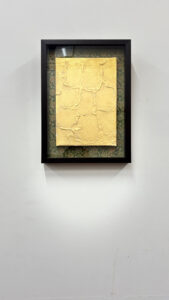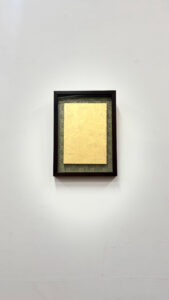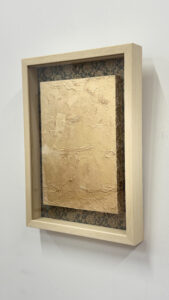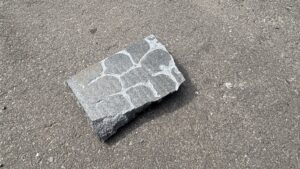When I saw this work, I was struck by the deliberate balance of composition used in this folding screen. It depicts real structures in a staged rather than realistic manner. I was particularly surprised by the overwhelming presence of Osaka Castle. The beautiful balance of the leaping roofs and stone walls is full of great power to produce the authority of the time.
Excavations have confirmed that the structure and ground of the stone walls of Osaka Castle differed between the Toyotomi and Tokugawa periods. In particular, it is thought that the composition and stacking of the stone walls depicted in the Toyotomi Period Osaka Screen shows an intention to symbolise the technology of the time, the castle’s defensive capabilities and its authority. In this research, I would like to reconsider the masonry by tracing and clarify the composition, balance and design intent of the stone walls in Osaka Castle during the Toyotomi and Tokugawa periods, and consider the technical and social context of each period to sublimate them into a work.
1. comparative analysis of the stone wall structures of the Toyotomi and Tokugawa periods: – to analyse the components of the ground and stone walls through image research based on excavation reports, and to consider the characteristics and differences of each period.
2. technical background of stone wall construction: – to compare differences in the origin, selection, stacking techniques and strength calculations of stone materials, and to investigate the composition and balance of stone walls.
- To analyse the development of castle-building techniques and design intentions in different periods.
3. Significance of stone walls in cultural and political contexts: – To interpret the design intent and symbolism of stone walls in relation to urban policy and power structures in the Toyotomi and Tokugawa periods.
Sayoko Suwabe 諏訪部 佐代子
sayokosuwabes.com
Born in Chiba Prefecture in 1995. Graduated from the Department of Oil Painting, Faculty of Fine Arts, Tokyo University of the Arts in 2019, and completed the Master’s Program in Global Art Practice at the same university in 2023. Received the “Salon de Printemps Award” at the 2017 Graduation Exhibition and the “GAP Award” at the 2022 Master’s Graduation Exhibition. Primarily creates installation works, but also works across a wide range of media including performance and sculpture. As of 2025, enrolled in the Doctoral Program in Printmaking, Painting Department, Graduate School of Tokyo University of the Arts, while also actively participating as a member of the artist collectives [Archaeological Practice], [Primipedites], and [NULLNULL STUDIO].
SDie Steinmauern der Burg Osaka unterscheiden sich in ihrer Struktur und im Untergrund zwischen der Toyotomi- und der Tokugawa-Zeit, wie archäologische Ausgrabungen gezeigt haben.
Insbesondere in der Darstellung der Steinmauern im Byōbu der Toyotomi-Zeit lassen sich Hinweise auf die damalige Bautechnik sowie auf Intentionen zur Verteidigung und zur symbolischen Repräsentation von Macht erkennen.
Ziel dieses Forschungsprojekts ist es, die Zusammensetzung, das Gleichgewicht und die gestalterische Intention der Steinmauern in den jeweiligen Epochen zu analysieren, ihre technischen und gesellschaftlichen Kontexte zu untersuchen und sie in einer künstlerischen Arbeit umzusetzen.
Vergleichende Analyse der Steinmauerstrukturen in der Toyotomi- und Tokugawa-Zeit:
Anhand archäologischer Grabungsberichte werden der Untergrund und die strukturellen Elemente der Steinmauern bildbasiert untersucht, um die Merkmale und Unterschiede beider Epochen zu verdeutlichen.
Technischer Hintergrund der Mauerwerkskonstruktion:
Es erfolgt eine vergleichende Untersuchung der Auswahl des Steinmaterials, der Mauertechnik und der statischen Berechnungen, um Zusammensetzung und Stabilität der Steinmauern zu analysieren.
Fortschritte in der Burgenbautechnik und die jeweiligen planerischen Absichten der beiden Epochen werden beleuchtet.
Kulturelle und politische Bedeutung der Steinmauern:
Die symbolische Bedeutung der Steinmauerkonstruktion wird im Zusammenhang mit der Stadtpolitik und den Machtstrukturen der Toyotomi- und Tokugawa-Zeit interpretiert.
Neue Betrachtung des Osaka-Byōbu aus der Toyotomi-Zeit:
Die Darstellung der Burgmauern auf dem Byōbu wird mit erhaltenen Quellen abgeglichen, um Hinweise auf die historische Realität und die damalige Architekturauffassung zu gewinnen.
Erwartete Ergebnisse:
Diese Forschung wird zur Klärung der strukturellen und technischen Unterschiede der Steinmauern der Burg Osaka in den jeweiligen Epochen beitragen, sowohl aus technischer als auch aus kultureller Perspektive. Sie wird darüber hinaus den dokumentarischen Wert des Osaka-Byōbu aus der Toyotomi-Zeit erhöhen und einen Beitrag zum besseren Verständnis der Entwicklungsprozesse der japanischen Burgenarchitektur leisten. Zudem wird erwartet, dass die Untersuchung ein tieferes Verständnis für die Verteidigungs- und Symbolfunktionen der Steinmauern vermittelt.
Sayoko Suwabe 諏訪部 佐代子
sayokosuwabes.com
Geboren 1995 in der Präfektur Chiba. 2019 Abschluss des Studiums der Ölmalerei an der Fakultät für Bildende Künste der Tokyo University of the Arts. 2023 Abschluss des Masterstudiengangs „Global Art Practice“ an derselben Universität.
Ausgezeichnet mit dem „Salon de Printemps Award“ auf der Abschlussausstellung 2017 sowie mit dem „GAP Award“ auf der Master-Abschlussausstellung 2022.
Die künstlerische Praxis umfasst hauptsächlich Installationen, erstreckt sich jedoch auch auf ein breites Spektrum an Medien, darunter Performance und Skulptur.
Seit 2025 ist die Künstlerin/der Künstler im Doktoratsstudiengang für Druckgrafik an der Abteilung für Malerei der Graduate School der Tokyo University of the Arts eingeschrieben und gleichzeitig aktives Mitglied der Künstlerkollektive [Archaeological Practice], [Primipedites] und [NULLNULL STUDIO].
大阪城の石垣は、豊臣時代と徳川時代で構造や地盤が異なることが発掘調査によって確認されています。特に、豊臣期大坂図屏風に描かれた石垣の構成や積み方には、当時の技術や城の防御力、権威を象徴する意図が見られると考えられます。今回のリサーチでは、豊臣期の大阪城と徳川期の大阪城における石垣の組成やバランス、設計意図について明確化を図り、それぞれの時代背景における技術的・社会的な文脈を考察し、作品へと昇華したいです。
豊臣期および徳川期の石垣構造の比較分析:
- 発掘調査報告書をもとに、地盤と石垣の構成要素をイメージ調査によって分析し、各時代の特徴や差異を明らかにする。
石垣構築の技術的背景:
- 石材の選定、積み方の技術、強度計算の違いを比較し、石垣の組成やバランスについて調査する。
- 各時代における築城技術の進展および、設計意図を分析する。
文化的および政治的文脈における石垣の意義:
- 石垣の設計意図とその象徴性について、豊臣時代および徳川時代の都市政策や権力構造との関係性から解釈を試みる。
豊臣期大坂図屏風の再考:
- 屏風に描かれた大阪城の石垣表現を現存資料と照合し、時代背景の反映や当時の築城思想を探る。
期待される成果:
この研究は、大阪城の石垣構造について、時代ごとの違いを技術的・文化的視点から明らかにし、豊臣期大坂図屏風の史料的価値を高めるとともに、豊臣期と徳川期の大阪城の設計思想や築城技術の変遷を明確化することに貢献します。また、石垣が持つ防御的・象徴的な意味を理解し、日本における城郭建築の発展過程を見直すことが期待されます。
Sayoko Suwabe 諏訪部 佐代子
sayokosuwabes.com
1995 年千葉県生まれ。2019 年東京藝術大学美術学部油画専攻卒業、2023 年同大学院グローバルアートプラクティス修士課程修了。卒業制作展 2017 で「サロン・ド・プランタン賞」、修士卒業制作展 2022 で「GAP 賞」受賞。インスタレーション作品を中心に、パフォーマンスや彫刻など幅広いメディアで制作を行う。2025年現在、博士課程に在籍しながらアーティストコレクティブ [実践考古学] [Primipedites] [NULLNULL STUDIO] のメンバーとしても活動する。




